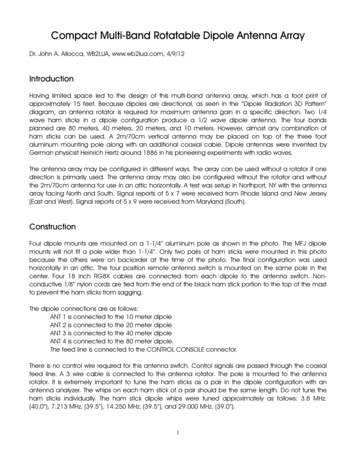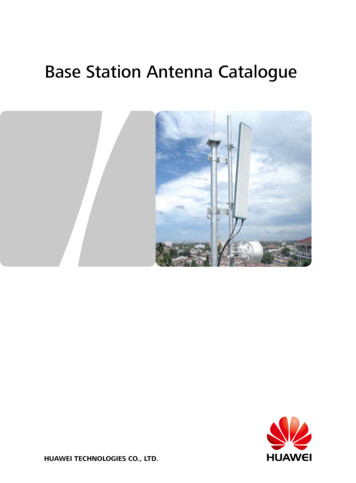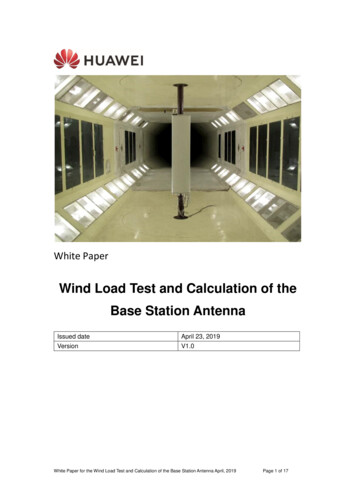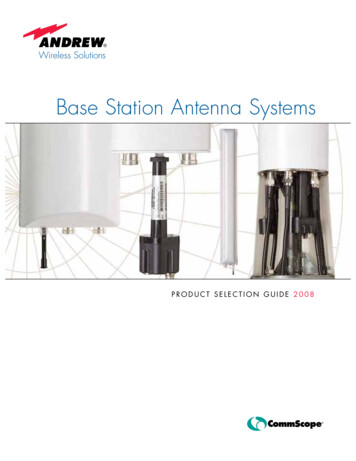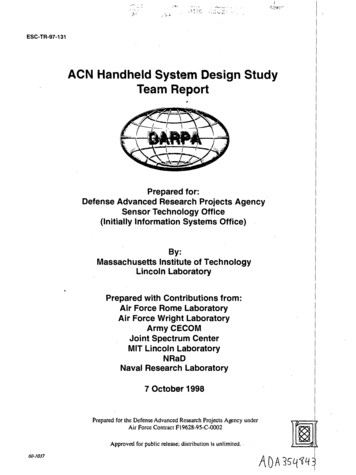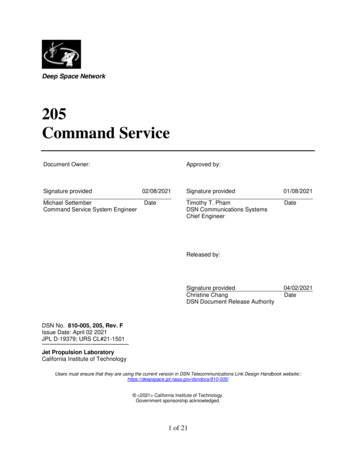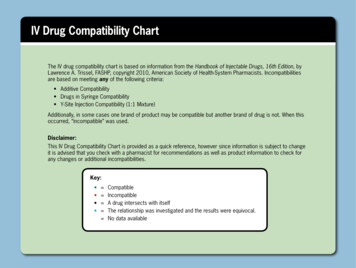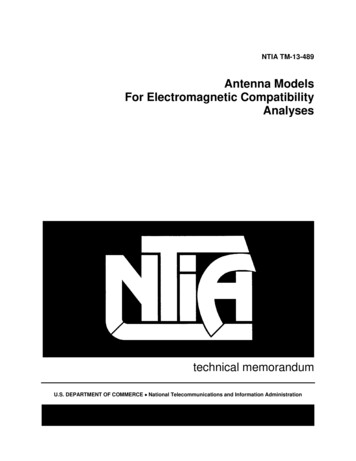
Transcription
NTIA TM-13-489Antenna ModelsFor Electromagnetic CompatibilityAnalysestechnical memorandumU.S. DEPARTMENT OF COMMERCE National Telecommunications and Information Administration
NTIA TM-13-489Antenna ModelsFor Electromagnetic CompatibilityAnalysesC.W. Wang, Ph.D.T. Keech, Ph.D.U.S. Department of CommerceRebecca Blank, Acting SecretaryLawrence E. Strickling, Assistant Secretaryfor Communications and InformationOctober 2012i
EXECUTIVE SUMMARYThe National Telecommunications and Information Administration (NTIA) is theExecutive Branch agency principally responsible for advising the President ontelecommunications and information policy issues. NTIA’s responsibilities include developingand articulating domestic and international telecommunications and information policiesconcerning spectrum allocation and utilization, presenting executive branch views ontelecommunications and information matters to Congress, the Federal CommunicationsCommission (FCC), and the public, and providing guidance to federal agencies to ensure theirtelecommunication activities are consistent with these policies.To fulfill these responsibilities, NTIA has undertaken numerous spectrum-related studiesto assess spectrum utilization and recommend changes to promote efficient and effectivespectrum utilization, examine the feasibility of reallocating spectrum used by the federalgovernment to the private sector, recommend changes to improve federal spectrum managementprocedures, and identify existing or potential electromagnetic compatibility (EMC) problemsbetween radio systems and provide recommendations to resolve EMC conflicts.NTIA and the federal agencies have long relied on engineering analyses and technicalstudies to assess compatibility between federal and non-federal radio systems and to evaluateemerging radio technologies. Unfortunately, regulators and the spectrum managementcommunity have yet to recognize a common set of approaches for conducting these analyses andstudies. Moreover, in light of the increasing spectrum demands, federal regulators and spectrummanagers must use analysis methods that accurately represent interference between radiosystems to ensure efficient and effective spectrum utilization.To make the analyses and studies more effective and accurate, NTIA, in coordinationwith the federal agencies and the FCC, is developing a Best Practices Handbook of engineeringanalytical tools and procedures with the aim of optimizing spectrum utilization. The handbookwill include appropriate transmitter and receiver technical standards, radio service-specificinterference protection criteria, limits of unwanted emission, frequency dependent environmentalcharacteristics, engineering models of antennas and radiowave propagation, and a description ofradio service-specific analysis models that address single and aggregate interference.To support the development of the handbook, NTIA’s Office of Spectrum Management,Spectrum Engineering and Analysis Division developed this technical memorandum to addressthe antenna characteristics for EMC analyses. The memorandum covers the antenna gainrequirements, radiation patterns, sidelobe requirements, and other technical data. The results ofthis memorandum will be incorporated into the Best Practices Handbook.This memorandum contains two compilations of antenna parameters. The first one is thecollection of rules, regulations, and recommendations regarding antennas that are published byauthoritative institutions and are relevant to EMC analyses. Various authoritative institutionshave published rules, regulations, and recommendations regarding antennas for regulating, aswell as improving, EMC, with the aim of optimizing spectrum efficiency. NTIA technical staffconducted an extensive search for the rules, regulations, and recommendations published byii
itself, the FCC, International Telecommunication Union, RTCA, Inc. (formerly Radio TechnicalCommission for Aeronautics), etc., and compiled the findings in this memorandum. Theinformation includes the antenna gain values, reference radiation patterns, sidelobe requirements,and other technical data. Thus, this memorandum is a library of the rules, regulations, andrecommendations regarding antennas that are relevant to EMC analyses. This will enableregulators and spectrum managers to easily identify the appropriate antenna parameters for theirEMC analyses.The second compilation is the recommendations of antenna parameters for NTIA and thefederal agencies to conduct their EMC analysis tasks. NTIA conducts the following EMCanalysis tasks for the federal agencies: system review for equipment approval, frequencyassignment, and spectrum sharing studies. The official source of antenna parameters for thesetasks is the NTIA’s Manual of Regulations and Procedures for Federal Radio FrequencyManagement. However, the Manual only provides antenna parameters for some radio services.NTIA technical staff evaluated the characteristics of the radio services, the federal usage of theradio spectrum, and the technical merit and practicality of the antenna parameters in the rules,regulations, and recommendations, and then developed recommendations of antenna parametersfor all of the radio services. These recommendations are compiled in this memorandum. Thus,this memorandum is also a library of the antenna parameters for NTIA and the federal agenciesto conduct their EMC analysis tasks.This technical memorandum is a living document. The content will be periodicallyreviewed for new and revised technical parameters from the authoritative institutions, and thememorandum will be revised accordingly.iii
TABLE OF CONTENTSEXECUTIVE SUMMARY . iiTABLE OF CONTENTS . ivLIST OF TABLES . xivLIST OF FIGURES . xxviACRONYMS ABBREVIATIONS AND SYMBOLS .xxxSECTION 1.1.11.21.31.4INTRODUCTION . 1-1Background . 1-1Objective . 1-1Approach . 1-2Scope . 1-3SECTION 2.2.12.22.3ANTENNA FUNDAMENTALS. 2-1Introduction . 2-1Near-Field and Far-Field Regions . 2-2Power and Gain . 2-32.3.1 Radiated Power . 2-32.3.2 Directive Gain and Power Gain . 2-4Radiation Pattern . 2-42.4.1 Characteristics . 2-42.4.2 Types of Patterns. 2-52.4.3 Reference Radiation Pattern . 2-72.4.4 Reciprocity . 2-8Efficiency . 2-8Beamwidth . 2-9Polarization . 2-92.7.1 Characteristics . 2-92.7.2 Co-Polarization and Cross-Polarization. 2-102.7.3 System Degradation due to Cross-Polarization . 2-112.7.4 Orthogonal Polarization Frequency Reuse . 2-12Antenna Noise and System Noise . 2-12Bandwidth . 2-132.42.52.62.72.82.9SECTION 3. COMMON ANTENNA TYPES . 3-13.1Introduction . 3-13.2Wire Antenna . 3-1iv
3.33.43.53.63.73.83.73.8SECTION 4.4.14.24.34.44.53.2.1 Dipole Antenna . 3-13.2.2 Variations of Dipole Antenna . 3-13.2.3 Loop Antenna. 3-53.2.4 Helical Antenna . 3-63.2.5 Yagi-Uda Antenna . 3-83.2.6 Rhombic Antenna . 3-9Aperture Antenna . 3-10Fractal Antenna . 3-11Microstrip Antenna . 3-12Lens Antenna . 3-12Reflector Antenna . 3-13Array Antenna . 3-17Billboard Reflector. 3-21Gains of Typical HF-Band Linear Antennas and Arrays. 3-22ANTENNA ESTIMATION AND MODELING TECHNIQUES . 4-1Introduction . 4-1Directional Antenna Directivity Calculation . 4-1Circular Reflector Antenna Gain and Beamwidth Calculation. 4-1Formulas for Modeling . 4-24.4.1 Wolfgain Formula for Low-Gain Antenna . 4-24.4.2 Statgain Formula for High-Gain Antenna. 4-34.4.3 ECAC Masks for Developing Reference Radiation Pattern . 4-4Numerical Methods for Computational Modeling . 4-64.5.1 Method of Moments . 4-64.5.2 Uniform Theory of Diffraction . 4-7SECTION 5. ANTENNA REFERENCE RADIATION PATTERNS ANDCHARACTERISTICS . 5-15.1Introduction . 5-15.2Fixed Service . 5-25.2.1 Point-to-Point System . 5-25.2.2 Point-to-Multipoint System . 5-115.2.3 System with High Altitude Platform Station . 5-165.3Fixed-Satellite Service . 5-175.3.1 Earth Station Antenna . 5-175.3.2 Satellite Antenna . 5-255.4Broadcasting Service . 5-305.4.1 AM Audio . 5-305.4.1.1Transmitting Antenna . 5-305.4.1.2Receiving Antenna . 5-365.4.2 FM Audio . 5-375.4.3 TV . 5-395.5Broadcasting-Satellite Service . 5-415.5.1 Earth Station Antenna . 5-415.5.1.1Feeder Link Transmitting Antenna . 5-425.5.1.2Downlink Receive-Only Antenna . 5-43v
5.5.25.65.75.85.95.105.115.125.13Satellite Antenna . 5-465.5.2.1Downlink Transmitting Antenna . 5-475.5.2.2Feeder Link Receiving Antenna . 5-47Mobile Service . 5-485.6.1 Land Mobile Service . 5-485.6.2 Maritime Mobile Service . 5-515.6.3 Aeronautical Mobile Service . 5-52Mobile Satellite Service . 5-545.7.1 Land Mobile Satellite Service . 5-545.7.1.1Earth Station Antenna . 5-545.7.1.2Satellite Antenna . 5-555.7.2 Maritime Mobile Satellite Service . 5-555.7.2.1Earth Station Antenna . 5-555.7.2.2Satellite Antenna . 5-565.7.3 Aeronautical Mobile Satellite Service . 5-565.7.3.1Earth Station Antenna . 5-575.7.3.2Satellite Antenna . 5-58Radiodetermination Service . 5-585.8.1 General Radiodetermination Service . 5-585.8.2 Radiolocation Service . 5-645.8.3 Radionavigation Service . 5-705.8.3.1Maritime Radionavigation Service . 5-715.8.3.2Aeronautical Radionavigation Service . 5-71Radiodetermination-Satellite Service . 5-765.9.1 Radiolocation-Satellite Service . 5-765.9.2 Radionavigation-Satellite Service . 5-85Radio Astronomy Service . 5-88Remote Sensing Service . 5-915.11.1 Meteorological Aids Service. 5-915.11.1.1 Meteorological Radar. 5-915.11.1.2 Meteorological Remote Sensing Devices . 5-955.11.1.3 Meteorological Optical Sensor . 5-985.11.2 Meteorological Satellite Services and Earth Exploration-Satellite . 5-1035.11.3 Space Research Service . 5-104Space Applications Service. 5-1095.12.1 Space Operation Service . 5-1095.12.2 Data Relay Service . 5-110Summary . 5-111SECTION 6. RECOMMENDATIONS . 6-16.1Introduction . 6-16.1.1 Objective . 6-16.1.2 Methodology . 6-16.2Fixed Service . 6-26.2.1 System Review. 6-36.2.1.1Standard Antenna . 6-36.2.1.1.1Masks . 6-3vi
6.36.46.56.66.2.1.1.2Evaluation . 6-46.2.1.1.3Recommendation . 6-96.2.1.2High Performance Antenna. 6-106.2.2 Frequency Assignment. 6-126.2.2.1Actual Radiation Pattern . 6-126.2.2.2Reference Radiation Pattern . 6-136.2.3 Spectrum Sharing Analyses . 6-186.2.3.1406.1 420 MHz . 6-196.2.3.2932.5 935 and 941.5 944 MHz . 6-206.2.3.31.71 1.85 GHz . 6-216.2.3.42.2 2.4 GHz . 6-226.2.3.54.4 4.99 GHz . 6-246.2.3.67.125 8.5 GHz . 6-256.2.3.714.4 15.35 GHz . 6-266.2.3.821.2 23.6 GHz . 6-286.2.3.925.25 27.5 GHz . 6-29Fixed-Satellite Service . 6-306.3.1 System Review. 6-306.3.1.1GSO System Earth Station Antenna Co-PolarizationRadiation Performance Standard . 6-316.3.1.2GSO System Earth Station Antenna CrossPolarization Radiation Performance Standard . 6-346.3.1.3NGSO System Earth Station Antenna Co-PolarizationRadiation Performance Standard . 6-366.3.2 Frequency Assignment. 6-376.3.3 Spectrum Sharing Analyses . 6-386.3.3.13.6 4.2 GHz Downlink . 6-396.3.3.25.85 6.425 GHz Uplink. 6-406.3.3.37.25 7.75 GHz Downlink . 6-416.3.3.47.9 8.4 GHz Uplink. 6-426.3.3.510.7 12.2 GHz Downlink . 6-446.3.3.614 14.5 GHz Uplink. 6-456.3.3.720.2 21.2 GHz Downlink . 6-466.3.3.830 31 GHz Uplink. 6-476.3.3.943 45 GHz Uplink. 6-486.3.3.10 1.35 1.39 GHz Downlink for NGSO System . 6-49Broadcasting Service . 6-50Broadcasting-Satellite Service . 6-50Mobile Service . 6-506.6.1 Land Mobile Service . 6-506.6.1.1System Review. 6-506.6.1.2Frequency Assignment. 6-526.6.1.3Spectrum Sharing Analyses . 6-536.6.1.3.1496–535 kHz . 6-546.6.1.3.21.605–1.8 MHz . 6-556.6.1.3.32–3.4 MHz . 6-55vii
6.76.6.1.3.44.438–8.1 MHz . 6-576.6.1.3.523.35–24.89 MHz . 6-586.6.1.3.625.33–26.95 MHz . 6-596.6.1.3.727.54–28 MHz . 6-596.6.1.3.829.89–75.4 MHz . 6-606.6.1.3.9138–150.08 MHz . 6-616.6.1.3.10 162–174 MHz . 6-636.6.1.3.11 220–420 MHz . 6-646.6.1.3.12 1.755–1.85 GHz . 6-666.6.1.3.13 2.2–2.395 GHz . 6-666.6.1.3.14 21.2–23.6 GHz . 6-676.6.2 Maritime Mobile Service . 6-686.6.2.1System Review. 6-686.6.2.2Frequency Assignment. 6-706.6.2.3Spectrum Sharing Analyses . 6-706.6.2.3.120–190 kHz . 6-726.6.2.3.2415–535 kHz . 6-726.6.2.3.32.065–2.194 MHz . 6-736.6.2.3.42–3.4 MHz . 6-746.6.2.3.54–5.9 MHz . 6-756.6.2.3.66.765–8.815 MHz . 6-766.6.2.3.712.23–19.8 MHz . 6-776.6.2.3.823.35–28 MHz . 6-786.6.2.3.9138–174 MHz . 6-796.6.3 Aeronautical Mobile Service . 6-806.6.3.1System Review. 6-806.6.3.2Frequency Assignment. 6-826.6.3.3Spectrum Sharing Analyses . 6-836.6.3.3.12 3.5 MHz . 6-856.6.3.3.24.438 5.73 MHz . 6-866.6.3.3.35.73 8.1MHz . 6-866.6.3.3.48.815 18.03 MHz . 6-876.6.3.3.521.924 23.35 MHz . 6-886.6.3.3.623.35 30.56 MHz . 6-896.6.3.3.732 50 MHz . 6-906.6.3.3.8117.975 137 MHz . 6-916.6.3.3.9138 150.8 MHz . 6-916.6.3.3.10 162.0125 174 MHz . 6-926.6.3.3.11 225 420 MHz Range . 6-936.6.3.3.12 1.35 1.525 GHz . 6-946.6.3.3.13 1.755 1.85 GHz . 6-946.6.3.3.14 4.4 4.94 GHz . 6-96Mobile-Satellite Service. 6-976.7.1 Land Mobile-Satellite Service . 6-986.7.1.1System Review. 6-986.7.1.2Frequency Assignment. 6-101viii
6.7.1.36.8Spectrum Sharing Analyses . 6-1016.7.1.3.1240 270 MHz Downlink . 6-1016.7.1.3.2290 320 MHz Uplink . 6-1026.7.1.3.31.525 1.559 GHz Downlink and1.61 1.6605 GHz Uplink. 6-1036.7.1.3.47.25 7.3 GHz Downlink and 7.9 8.025GHz Uplink . 6-1036.7.1.3.539.5 40.5 GHz Downlink and 43.5 47GHz Uplink . 6-1046.7.2 Maritime Mobile-Satellite Service . 6-1046.7.2.1System Review. 6-1046.7.2.2Frequency Assignment. 6-1066.7.2.3Spectrum Sharing Analyses . 6-1066.7.2.3.1240 270 MHz Downlink . 6-1076.7.2.3.2290 320 MHz Uplink . 6-1076.7.2.3.31.525 1.559 GHz Downlink and1.61 1.6605 GHz Uplink. 6-1086.7.2.3.420.2 21.2 GHz Downlink . 6-1096.7.2.3.530 31 GHz Uplink. 6-1096.7.2.3.639.5 40.5 GHz Downlink and 43.5 47GHz Uplink . 6-1106.7.3 Aeronautical Mobile-Satellite Service . 6-1116.7.3.1System Review. 6-1116.7.3.2Frequency Assignment. 6-1136.7.3.3Spectrum Sharing Analyses . 6-1136.7.3.3.1240 270 MHz Downlink . 6-1146.7.3.3.2290 320 MHz Uplink . 6-1146.7.3.3.320.2 21.2 GHz Downlink . 6-1156.7.3.3.430 31 GHz Uplink. 6-1156.7.3.3.539.5 40.5 GHz Downlink and 43.5 47GHz Uplink . 6-116Radiodetermination Service . 6-1166.8.1 Radiolocation Service . 6-1176.8.1.1System Review. 6-1176.8.1.2Frequency Assignment. 6-1186.8.1.3Spectrum Sharing Analyses . 6-1206.8.1.3.11.705–1.8 MHz . 6-1216.8.1.3.2216–217 MHz . 6-1216.8.1.3.3420–450 MHz . 6-1226.8.1.3.4902–928 MHz . 6-1246.8.1.3.51.215–1.3 GHz . 6-1266.
Spectrum Engineering and Analysis Division developed this technical memorandum to address the antenna characteristics for EMC analyses. The memorandum covers the antenna gain requirements, radiation patterns, sidelobe requirements, and other technical data. The results of this memorandum will be incorporated into the Best Practices Handbook.
